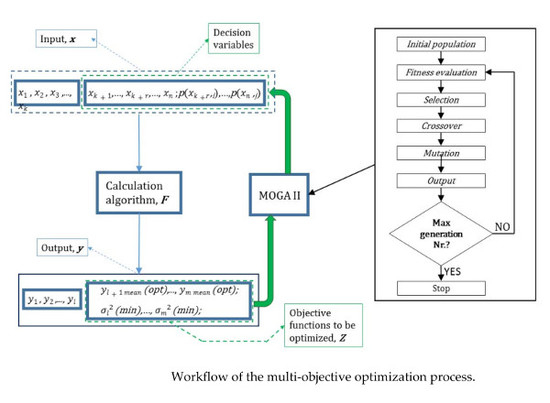The Key Role of the Vector Optimization Algorithm and Robust Design Approach for the Design of Polygeneration Systems
Abstract
1. Introduction
- the instability of the results due to mismatches between the marketed CHP engines and those provided by the calculation procedure;
- the instability of the results due to variations in the reference energetic and electricity tariff scenarios.
2. The Proposed Methodology
2.1. The Vector Optimization Approach for CHP System Optimization
The Evaluation Algorithm
- -
- annual electrical () and thermal load () of the user;
- -
- nominal electrical power of the CHP gas engine () and their number ();
- -
- reference efficiency for thermo-electric power generation ();
- -
- average boiler efficiency ();
- -
- CHP plant maintenance costs for kWh of generated electrical energy ();
- -
- fuel lower heating value ();
- -
- electrical energy price based on a three-tier time-of-use (TOU) tariff, not including VAT (;
- -
- electricity taxation ;
- -
- electrical energy selling price in the billing periods ();
- -
- the selling price of energy efficiency certificates (EECs) for cogeneration plants to be recognized as highly efficient ();
- -
- natural gas tariff, not including VAT ();
- -
- natural gas taxation ();
- -
- peak demand charge ();
- -
- discount rate ();
- -
- lifetime of the plant ().
2.2. The Multi-Objective Approach for ORC System Optimization
3. Analyses and Results
3.1. CHP Plant Configuration Optimization
3.2. ORC System Optimization
4. Conclusions
Author Contributions
Conflicts of Interest
Nomenclature
| discount rate | |
| area [m2] | |
| total area for the heat exchange [m2] | |
| hourly electrical energy delivered by the CHP plant and self-consumed by the user [kWh] | |
| primary energy [kWh] | |
| yearly electrical energy supplied by the CHP plant [kWh] | |
| yearly electrical energy supplied by the CHP plant exceeding the user needs [kWh] | |
| yearly electrical energy integrated by the electrical grid [kWh] | |
| yearly primary energy supplied to the CHP plant [kWh] | |
| yearly thermal energy supplied by the CHP plant [kWh] | |
| yearly thermal energy integrated by auxiliary boilers [kWh] | |
| factor representative of transmission and transformation losses on the electrical grid [-] | |
| actual thermal power provided by the CHP plant [kW] | |
| nominal thermal power of a single CHP gas engine [kW] | |
| average power output of the CHP during the tth time interval | |
| average electrical load of the user during the tth time interval of the year | |
| electrical power to be integrated from the electrical grid during the tth time interval | |
| nominal electrical power of each CHP gas engine [kW] | |
| std dev | standard deviation of the considered quantity |
| CHP | combined heat and power |
| CCHP | combined cooling, heat, and power |
| DoE | design of experiment |
| EEC | energy efficiency certificates |
| ICE | internal combustion engine |
| MOGA | multi-objective genetic algorithm |
| MORDO | multi-objective robust design optimization |
| PES | primary energy savings |
| PS | proposed system (CHP) |
| PV | photovoltaic |
| RDO | robust design optimization |
| RS | reference system (separate production of electrical and thermal energy demand) |
| SPB | simple payback period |
| TPES | total (or technical) primary energy savings |
| duration of the time interval (1 h in this paper) | |
| superheating at the evaporator outlet [°C] | |
| subcooling at the condenser outlet [°C] | |
| regenerator efficiency or degree of regeneration [-] | |
| average boiler efficiency [-] | |
| nominal electrical efficiency of the CHP gas engine [-] | |
| global electric efficiency [-] | |
| reference efficiency for thermo-electric power generation [-] | |
| average efficiency of the Italian thermoelectric power generation [-] | |
| actual thermal efficiency of the cogeneration plant () [-] | |
| nominal thermal efficiency of the cogeneration plant [-] | |
| reference efficiency for thermal energy production [-] | |
| cond | condenser |
| eva | evaporator |
| reg | regenerator |
References
- Gimelli, A.; Muccillo, M. Optimization Criteria for Cogeneration Systems: Multi-Objective Approach and Application in a Hospital Facility. Appl. Energy 2013, 104, 910–923. [Google Scholar] [CrossRef]
- International Energy Agency. Key World Energy Statistics; International Energy Agency: Paris, France, 2016. [Google Scholar]
- International Energy Agency. Energy Technology Perspectives; International Energy Agency: Paris, France, 2014; ISBN 978-92-64-20800-1. [Google Scholar]
- International Energy Agency. World Energy Outlook; International Energy Agency: Paris, France, 2016. [Google Scholar]
- Stambouli, A.B.; Traversa, E. Solid oxide fuel cells (SOFCs): A review of an environmentally clean and efficient source of energy. Renew. Sustain. Energy Rev. 2002, 6, 433–455. [Google Scholar] [CrossRef]
- Fontanesi, S.; Severi, E.; Bozza, F.; Gimelli, A. Investigation of Scavenging, Combustion and Knock in a Two-Stroke SI Engine Operated with Gasoline and CNG. Int. J. Automot. Eng. 2012, 3, 97–105. [Google Scholar]
- De Simio, L.; Gambino, M.; Iannaccone, S.; Borrelli, L.; Gimelli, A.; Muccillo, M. Experimental Analysis of a Natural Gas Fueled Engine and 1-D Simulation of VVT and VVA Strategies. In Proceedings of the ICE2013—11th International Conference on Engines & Vehicles, Capri, Italy, 15–19 September 2013. SAE Technical Paper number 2013-24-0111. [Google Scholar] [CrossRef]
- Gimelli, A.; Muccillo, M.; Pennacchia, O. The Study of a New Mechanical VVA System. Part I: Valve Train Design and Friction Modeling. Int. J. Res. Engines 2015, 16, 750–761. [Google Scholar] [CrossRef]
- Gimelli, A.; Muccillo, M.; Pennacchia, O. Study of a New Mechanical VVA System. Part II: Estimation of the Actual Fuel Consumption Improvement through 1D Fluid Dynamic Analysis and Valve Train Friction Estimation. Int. J. Engine Res. 2015, 16, 762–772. [Google Scholar] [CrossRef]
- De Nola, F.; Giardiello, G.; Gimelli, A.; Molteni, A.; Muccillo, M.; Picariello, R. A Model-Based Computer Aided Calibration Methodology Enhancing Accuracy, Time and Experimental Effort Savings through Regression Techniques and Neural Networks. In Proceedings of the ICE2017—13th International Conference on Engines and Vehicles, Capri, Italy, 10–14 September 2017. SAE Technical Paper # 2017-24-0054. [Google Scholar] [CrossRef]
- De Bellis, V.; Gimelli, A.; Muccillo, M. Effects of Pre-Lift Intake Valve Strategies on the Performance of a DISI VVA Turbocharged Engine at Part and Full Load Operation. Energy Procedia 2015, 81, 874–882. [Google Scholar] [CrossRef]
- Serra, L.M.; Lozano, M.A.; Ramos, J.; Ensinas, A.V.; Nebra, S.A. Polygeneration and efficient use of natural resources. Energy 2009, 34, 575–586. [Google Scholar] [CrossRef]
- Calise, F.; Figaj, R.D.; Massarotti, N.; Mauro, A.; Vanoli, L. Polygeneration system based on PEMFC, CPVT and electrolyzer: Dynamic simulation and energetic and economic analysis. Appl. Energy 2017, 192, 530–542. [Google Scholar] [CrossRef]
- Calise, F.; Cipollina, A.; Dentice D’Accadia, M.; Piacentino, A. A novel renewable polygeneration system for a small Mediterranean volcanic island for the combined production of energy and water: Dynamic simulation and economic assessment. Appl. Energy 2014, 135, 675–693. [Google Scholar] [CrossRef]
- Guo, Z.; Wang, Q.; Fang, M.; Luo, Z.; Cen, K. Thermodynamic and economic analysis of polygeneration system integrating atmospheric pressure coal pyrolysis technology with circulating fluidized bed power plant. Appl. Energy 2014, 113, 1301–1314. [Google Scholar] [CrossRef]
- Buonomano, A.; Calise, F.; Ferruzzi, G.; Vanoli, L. A novel renewable polygeneration system for hospital buildings: Design, simulation and thermo-economic optimization. Appl. Therm. Eng. 2014, 67, 43–60. [Google Scholar] [CrossRef]
- Bracco, S.; Delfino, F.; Pampararo, F.; Robba, M.; Rossi, M. A dynamic optimization-based architecture for polygeneration microgrids with tri-generation, renewables, storage systems and electrical vehicles. Energy Convers. Manag. 2015, 96, 511–520. [Google Scholar] [CrossRef]
- El-Emam, R.S.; Dincer, I. Assessment and Evolutionary Based Multi-Objective Optimization of a Novel Renewable-Based Polygeneration Energy System, ASME. J. Energy Resour. Technol. 2016, 139, 012003. [Google Scholar] [CrossRef]
- Calise, F.; D’Accadia, M.D.; Libertini, L.; Quiriti, E.; Vicidomini, M. A novel tool for thermoeconomic analysis and optimization of trigeneration systems: A case study for a hospital building in Italy. Energy 2017, 126, 64–87. [Google Scholar] [CrossRef]
- Song, H.; Starfelt, F.; Daianova, L.; Yan, J. Influence of drying process on the biomass-based polygeneration system of bioethanol, power and heat. Appl. Energy 2012, 90, 32–37. [Google Scholar] [CrossRef]
- D’Accadia, M.D.; Sasso, M.; Sibilio, S.; Vanoli, L. Micro-combined heat and power in residential and light commercial applications. Appl. Therm. Eng. 2003, 23, 1247–1259. [Google Scholar] [CrossRef]
- Muccillo, M.; Gimelli, A. Experimental Development, 1D CFD Simulation and Energetic Analysis of a 15 kW Micro-CHP Unit based on Reciprocating Internal Combustion Engine. Appl. Therm. Eng. 2014, 71, 760–770. [Google Scholar] [CrossRef]
- Merkel, E.; McKenna, R. Wolf Fichtner, Optimisation of the capacity and the dispatch of decentralised micro-CHP systems: A case study for the UK. Appl. Energy 2015, 140, 120–134. [Google Scholar] [CrossRef]
- Monteiro, E.; Moreira, N.A.; Ferreira, S. Planning of micro-combined heat and power systems in the Portuguese scenario. Appl. Energy 2009, 86, 290–298. [Google Scholar] [CrossRef]
- Sannino, R. Thermal characterization of CHP-User Needs interaction and optimized choice of the Internal Combustion Engines in the CHP plants. Energy Procedia 2015, 82, 929–935. [Google Scholar] [CrossRef]
- Xie, D.; Lu, Y.; Sun, J.; Gu, C.; Yu, J. Optimal Operation of Network-Connected Combined Heat and Powers for Customer Profit Maximization. Energies 2016, 9, 442. [Google Scholar] [CrossRef]
- Ahmadi, P.; Marc Rosen, A.; Dincer, I. Multi-objective exergy-based optimization of a polygeneration energy system using an evolutionary algorithm. Energy 2012, 46, 21–31. [Google Scholar] [CrossRef]
- Calise, F.; D’Accadia, M.D.; Macaluso, A.; Piacentino, A.; Vanoli, L. Exergetic and exergoeconomic analysis of a novel hybrid solar-geothermal polygeneration system producing energy and water. Energy Convers. Manag. 2016, 115, 200–220. [Google Scholar] [CrossRef]
- Maraver, D.; Uche, J.; Royo, J. Assessment of high temperature organic Rankine cycle engine for polygeneration with MED desalination: A preliminary approach. Energy Convers. Manag. 2012, 53, 108–117. [Google Scholar] [CrossRef]
- Fang, F.; Wei, L.; Liu, J.; Zhang, J.; Hou, G. Complementary configuration and operation of a CCHP-ORC system. Energy 2012, 46, 211–220. [Google Scholar] [CrossRef]
- Gimelli, A.; Muccillo, M. Regulation Problems of Combined Cycle Gas-Steam Turbine Power Plant in a Liberalized Market: Part I—Experimental Investigation and Energetic Analysis. Int. Rev. Modell. Simul. 2016, 9, 1974–9821. [Google Scholar] [CrossRef]
- Gimelli, A.; Muccillo, M. Regulation Problems of Combined Cycle Gas-Steam Turbine Power Plant in a Liberalized Market: Part II—Thermodynamic Analysis. Int. Rev. Modell. Simul. 2016, 9, 348–354. [Google Scholar] [CrossRef]
- Cameretti, M.C.; Muccillo, M. Combined MGT-ORC solar—Hybrid system. PART A: Plant optimization. Energy Procedia 2015, 81, 368–378. [Google Scholar] [CrossRef]
- Cameretti, M.C.; Ferrara, F.; Gimelli, A.; Tuccillo, R. Combined MGT-ORC solar-hybrid system. PART B: Component analysis and prime mover selection. Energy Procedia 2015, 81, 379–389. [Google Scholar] [CrossRef][Green Version]
- Gimelli, A.; Luongo, A.; Muccillo, M. Efficiency and cost optimization of a regenerative Organic Rankine Cycle power plant through the multi-objective approach. Appl. Therm. Eng. 2017, 114, 601–610. [Google Scholar] [CrossRef]
- Gimelli, A.; Muccillo, M.; Sannino, R. Optimal design of modular cogeneration plants for hospital facilities and robustness evaluation of the results. Energy Convers. Manag. 2017, 134, 20–31. [Google Scholar] [CrossRef]
- Gimelli, A.; Muccillo, M.; Sannino, R. Effects of uncertainties on the stability of the results of an optimal sized modular cogeneration plant. Energy Procedia 2017, 126, 369–376. [Google Scholar] [CrossRef]
- Akbari, K.; Nasiri, M.M.; Jolai, F.; Ghaderi, S.F. Optimal investment and unit sizing of distributed energy systems under uncertainty: A robust optimization approach. Energy Build 2014, 85, 275–286. [Google Scholar] [CrossRef]
- Gu, C.-H.; Xie, D.; Sun, G.-B.; Wang, X.-T.; Ai, Q. Optimal operation of combined heat and power system based on forecasted energy prices in real-time markets. Energies 2015, 8, 14330–14345. [Google Scholar] [CrossRef]
- Alvarado, D.C.; Acha, S.; Shah, N.; Markides, C.N. A Technology Selection and Operation (TSO) optimisation model for distributed energy systems: Mathematical formulation and case study. Appl. Energy 2016, 180, 491–503. [Google Scholar] [CrossRef]
- Piacentino, A.; Cardona, F. EABOT—Energetic analysis as a basis for robust optimization of trigeneration systems by linear programming. Energy Convers. Manag. 2008, 49, 3006–3016. [Google Scholar] [CrossRef]
- Bertsimas, D.; Sim, M. The Price of Robustness. Oper. Res. 2004, 52, 35–53. [Google Scholar] [CrossRef]
- Büsing, C.; D’Andreagiovanni, F. New Results about Multi-band Uncertainty in Robust Optimization. In International Symposium on Experimental Algorithms; Klasing, R., Ed.; Springer: Berlin/Heidelberg, Germany, 2012; Volume 7276, ISBN 978-3-642-30849-9. [Google Scholar]
- Yu, X.; Jin, Y.; Tang, K.; Yao, X. Robust optimization over time—A new perspective on dynamic optimization problems. In Proceedings of the IEEE Congress on Evolutionary Computation, Barcelona, Spain, 18–23 July 2010; pp. 1–6. [Google Scholar]
- Ferrara, F.; Gimelli, A.; Luongo, A. Small-scale concentrated solar power (CSP) plant: ORCs comparison for different organic fluids. Energy Procedia 2013, 45, 217–226. [Google Scholar] [CrossRef]
- Tchanche, B.F.; Lambrinos, G.; Frangoudakis, A.; Papadakis, G. Low-grade heat conversion into power using organic Rankine cycles—A review of various applications. Renew. Sustain. Energy Rev. 2011, 15, 3963–3979. [Google Scholar] [CrossRef]
- Schuster, A.; Karellas, S.; Kakaras, E.; Spliethoff, H. Energetic and economic investigation of Organic Rankine Cycle applications. Appl. Therm. Eng. 2009, 29, 1809–1817. [Google Scholar] [CrossRef]
- Özkaraca, O.; Keçebas, P.; Demircan, C.; Keçebas, A. Thermodynamic Optimization of a Geothermal-Based Organic Rankine Cycle System Using an Artificial Bee Colony Algorithm. Energies 2017, 10, 1691. [Google Scholar] [CrossRef]
- Pezzuolo, A.; Benato, A.; Stoppato, A.; Mirandola, A. The ORC-PD: A versatile tool for fluid selection and Organic Rankine Cycle unit design. Energy 2016, 102, 605–620. [Google Scholar] [CrossRef]
- Sayyaadi, H. Multi-objective approach in thermoenvironomic optimization of a benchmark cogeneration system. Appl. Energy 2009, 86, 867–879. [Google Scholar] [CrossRef]
- Wang, J.-J.; Jing, Y.-Y.; Zhang, C.-F. Optimization of capacity and operation for CCHP system by genetic algorithm. Appl. Energy 2010, 87, 1325–1335. [Google Scholar] [CrossRef]
- Gimelli, A.; Sannino, R. A multi-variable multi-objective methodology for experimental data and thermodynamic analysis validation: An application to micro gas turbines. Appl. Therm. Eng. 2018, 134, 501–512. [Google Scholar] [CrossRef]
- Toffolo, A.; Lazzaretto, A. Evolutionary algorithms for multi-objective energetic and economic optimization in thermal system design. Energy 2002, 27, 549–567. [Google Scholar] [CrossRef]
- Das, I.; Dennis, J. Normal boundary intersection, Alternate method for generating Pareto optimal points in multicriteria optimization problems. Available online: http://www.dtic.mil/dtic/tr/fulltext/u2/a320782.pdf (accessed on 18 February 2018).
- Coello, C.A.; Van Veldhuizen, D.A.; Lamont, G.B. Evolutionary Algorithms for Solving Multi-Objective Problems; Springer: New York, NY, USA, 2007. [Google Scholar]
- Lotov, A.V.; Bushenkov, V.A.; Kamenev, G.K. Interactive Decision Maps: Approximation and Visualization of Pareto Frontier; Kluwer Academic Publishers: Boston, MA, USA, 2004. [Google Scholar]
- Ngatchou, P.; Zarei, A.; El-Sharkawi, M.A. Pareto multi-objective optimization. In Proceedings of the 13th International Conference on Intelligent Systems Application to Power Systems, Arlington, VA, USA, 6–10 November 2005; pp. 84–91. [Google Scholar]
- Branke, J.; Deb, K.; Miettinen, K.; Slowinski, R. Multiobjective Optimization. Interactive and Evolutionary Approaches; Springer: Berlin, Germany, 2008; ISBN 978-3-540-88908-3. [Google Scholar]
- Poloni, C.; Giurgevich, A.; Onesti, L.; Pediroda, V. Hybridization of a multi-objective genetic algorithm, a neural network and a classical optimizer for a complex design problem in fluid dynamics. Comput. Methods Appl. Mech. Engrgy 2000, 186, 403–420. [Google Scholar] [CrossRef]
- Poloni, C.; Pediroda, V. GA coupled with computationally expensive simulations: Tools to improve efficiency. In Genetic Algorithms and Evolution Strategies in Engineering and Computer Science; John Wiley and Sons: Chichester, NH, USA, 1997; pp. 267–288. ISBN 0471977101. [Google Scholar]
- Padovan, L.; Pediroda, V.; Poloni, C. Multi objective robust design optimization of airfoils in transonic field (M.O.R.D.O.). In Proceedings of the International Congress on Evolutionary Methods for Design, Optimization and Control with Applications to Industrial Problems EUROGEN 2003, Barcelona, Spain, 15–17 September 2003. [Google Scholar]
- Vélez, F.; Segovia, J.J.; Martín, M.C.; Antolín, G.; Chejne, F.; Quijano, A. A technical, economical and market review of organic Rankine cycles for the conversion of low-grade heat for power generation. Renew. Sustain. Energy Rev. 2012, 16, 4175–4189. [Google Scholar] [CrossRef]
- Wang, J.; Yan, Z.; Wang, M.; Ma, S.; Dai, Y. Thermodynamic analysis and optimization of an (organic Rankine cycle) ORC using low grade heat source. Energy 2013, 49, 356–365. [Google Scholar] [CrossRef]
- Lemmens, S. Cost Engineering Techniques and Their Applicability for Cost Estimation of Organic Rankine Cycle Systems. Energies 2016, 9, 485. [Google Scholar] [CrossRef]
- Wang, J.; Yan, Z.; Wang, M.; Li, M.; Dai, Y. Multi-objective optimization of an organic Rankine cycle (ORC) for low grade waste heat recovery using evolutionary algorithm. Energy Convers. Manag. 2013, 71, 146–158. [Google Scholar] [CrossRef]
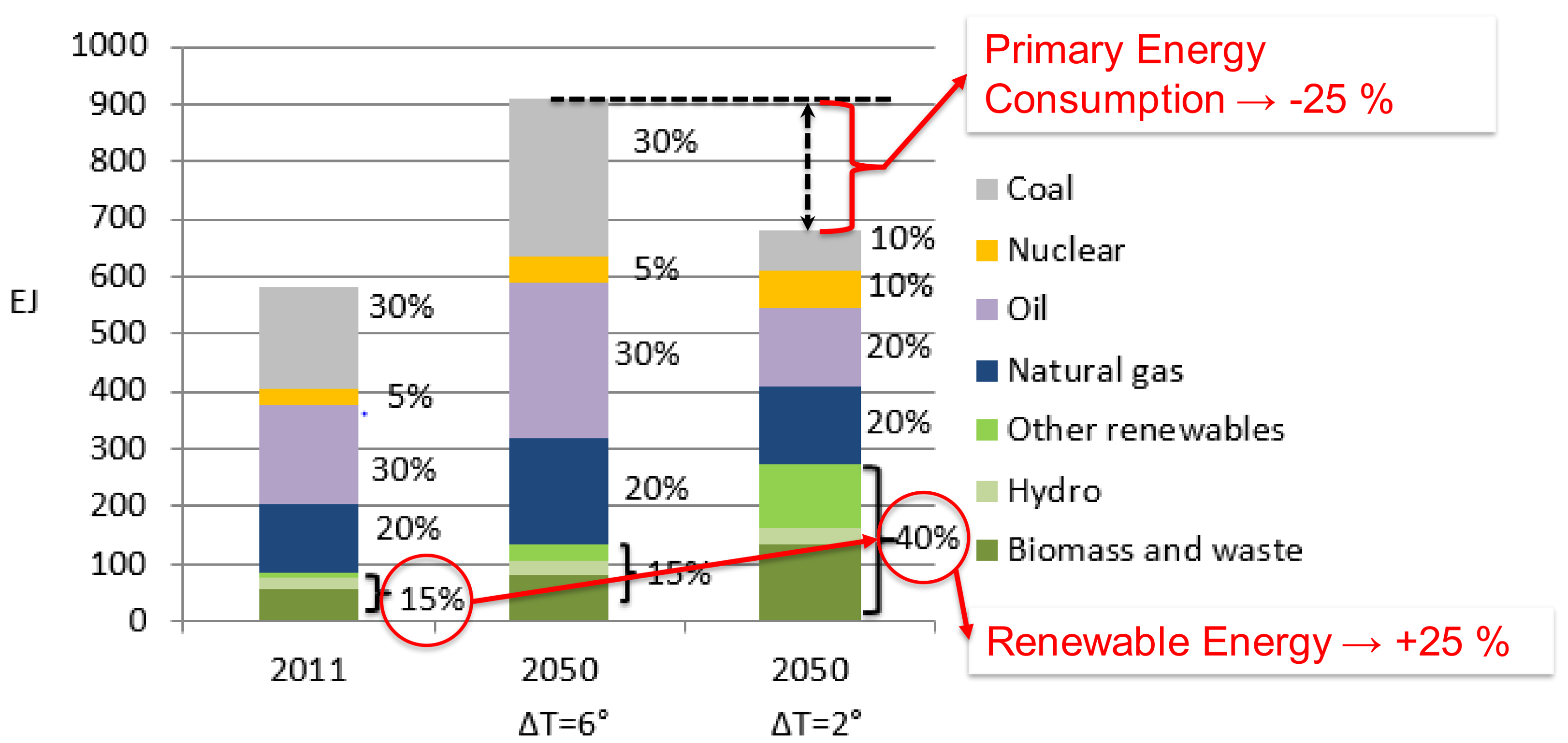
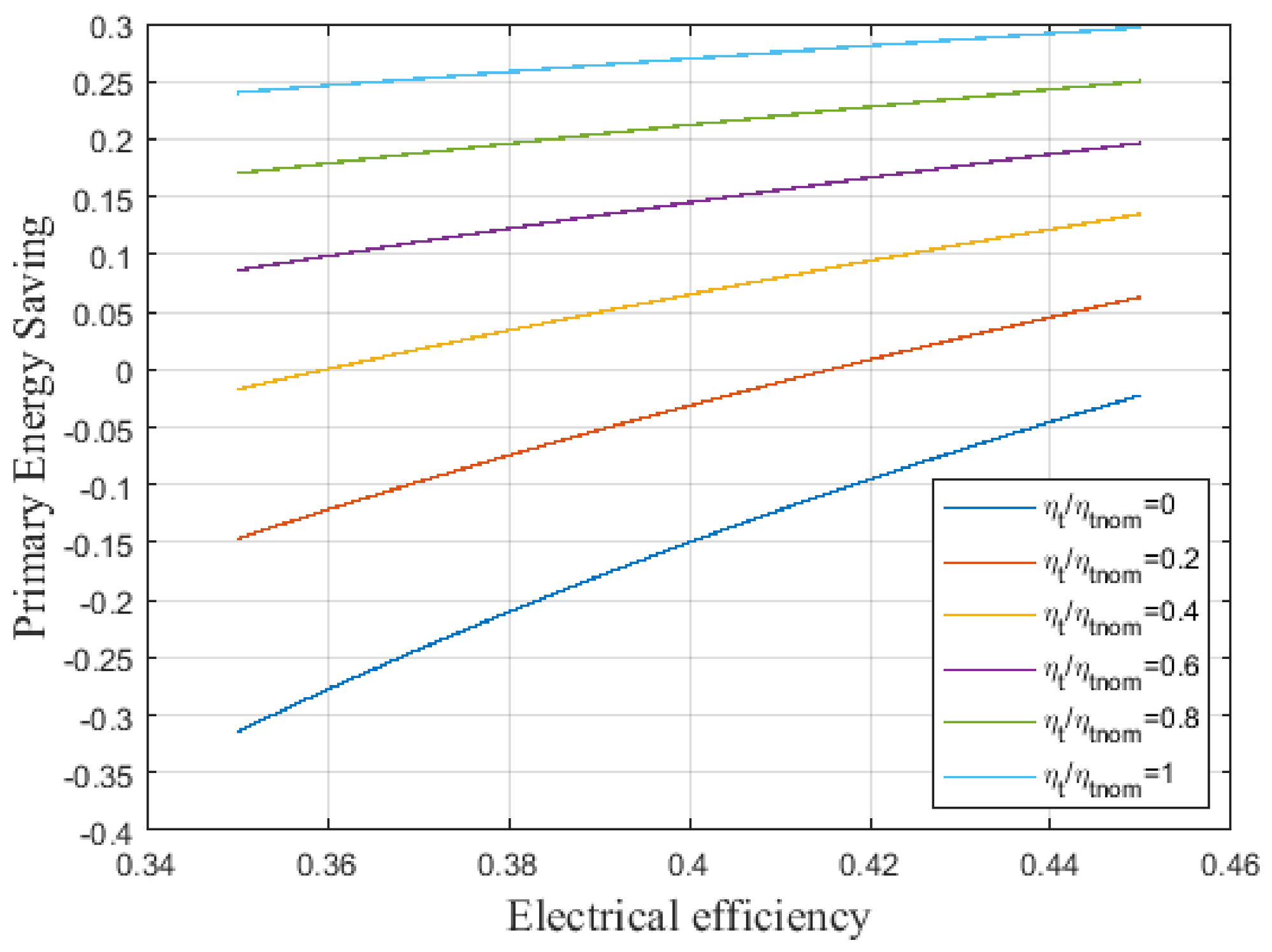
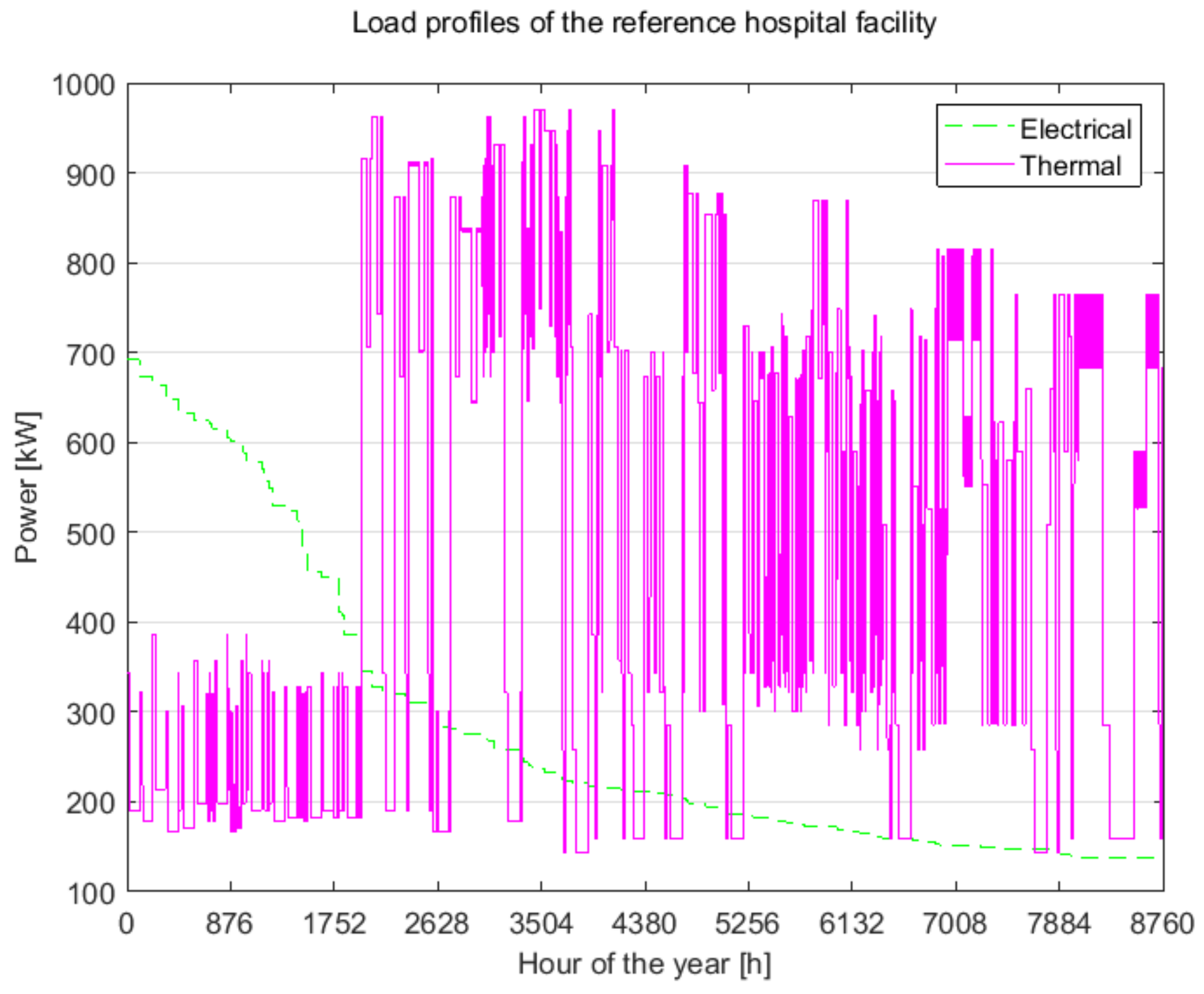
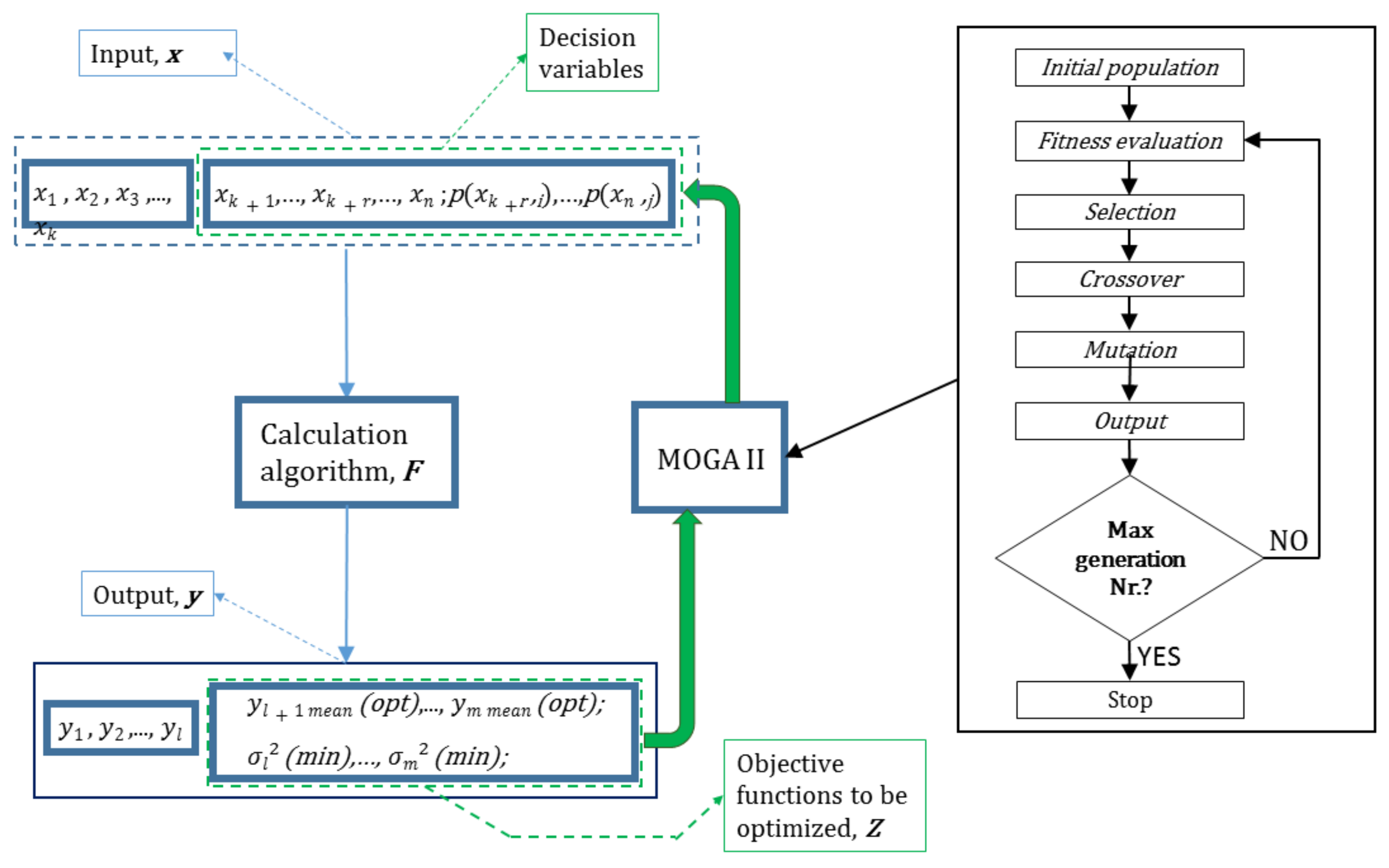
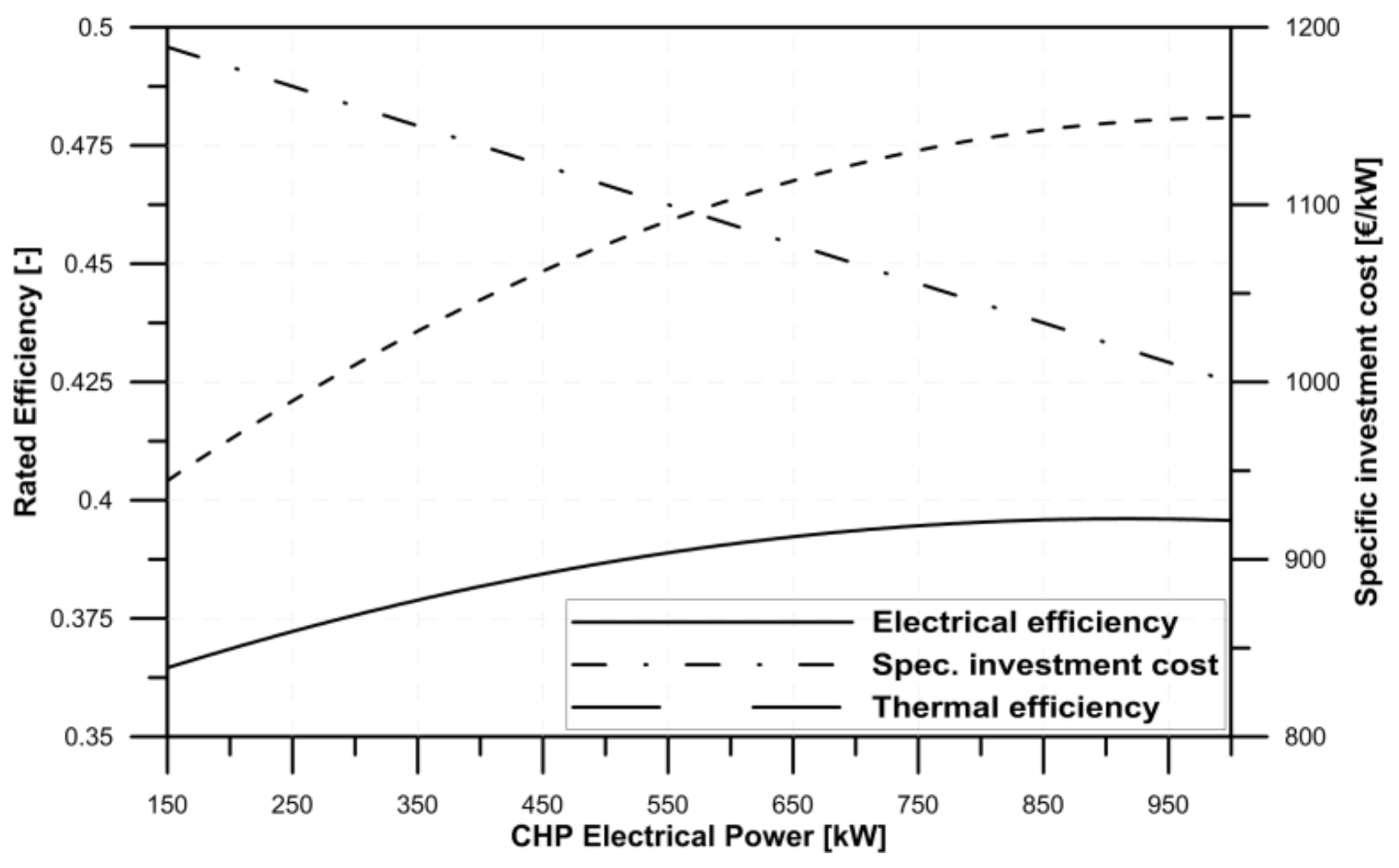
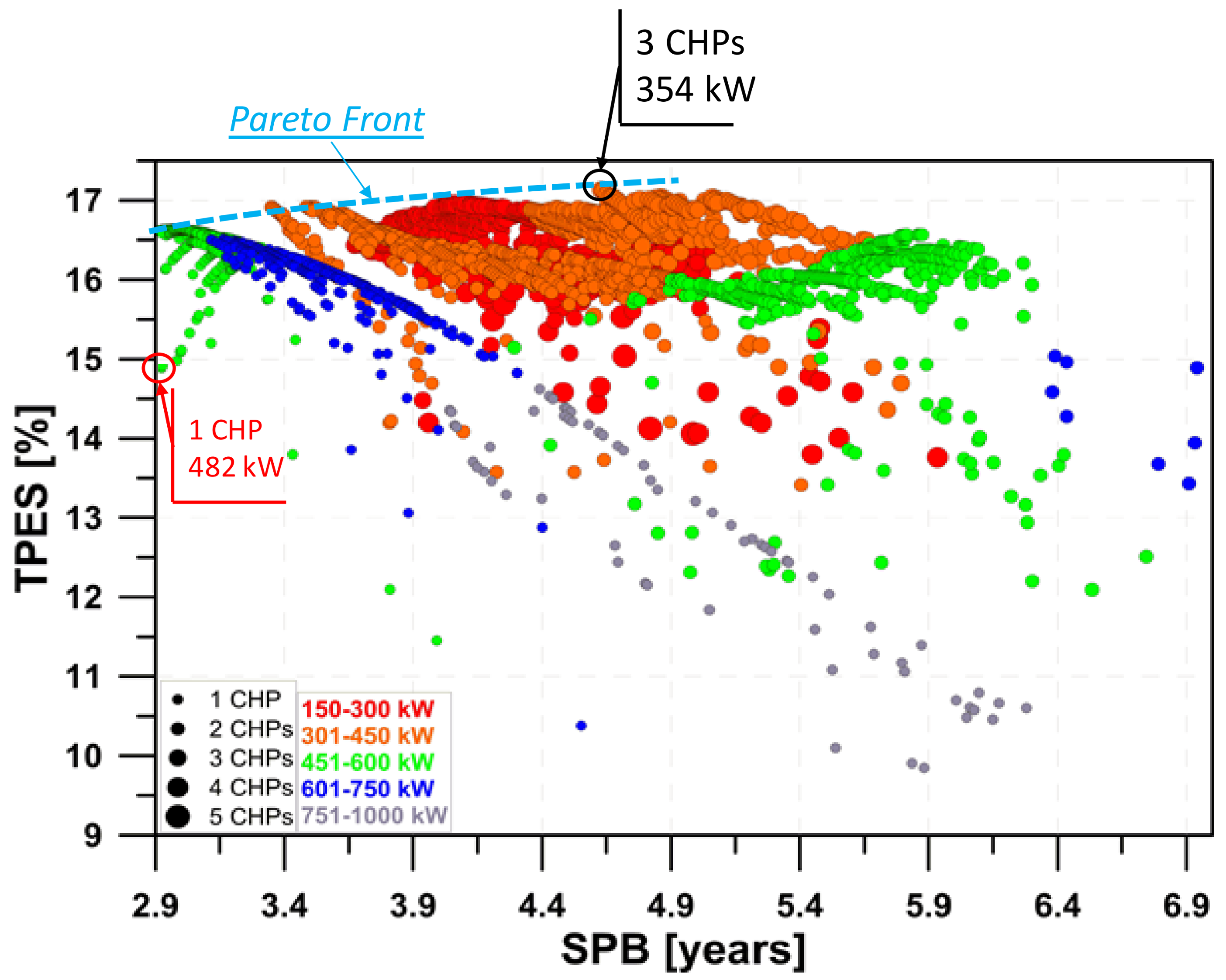
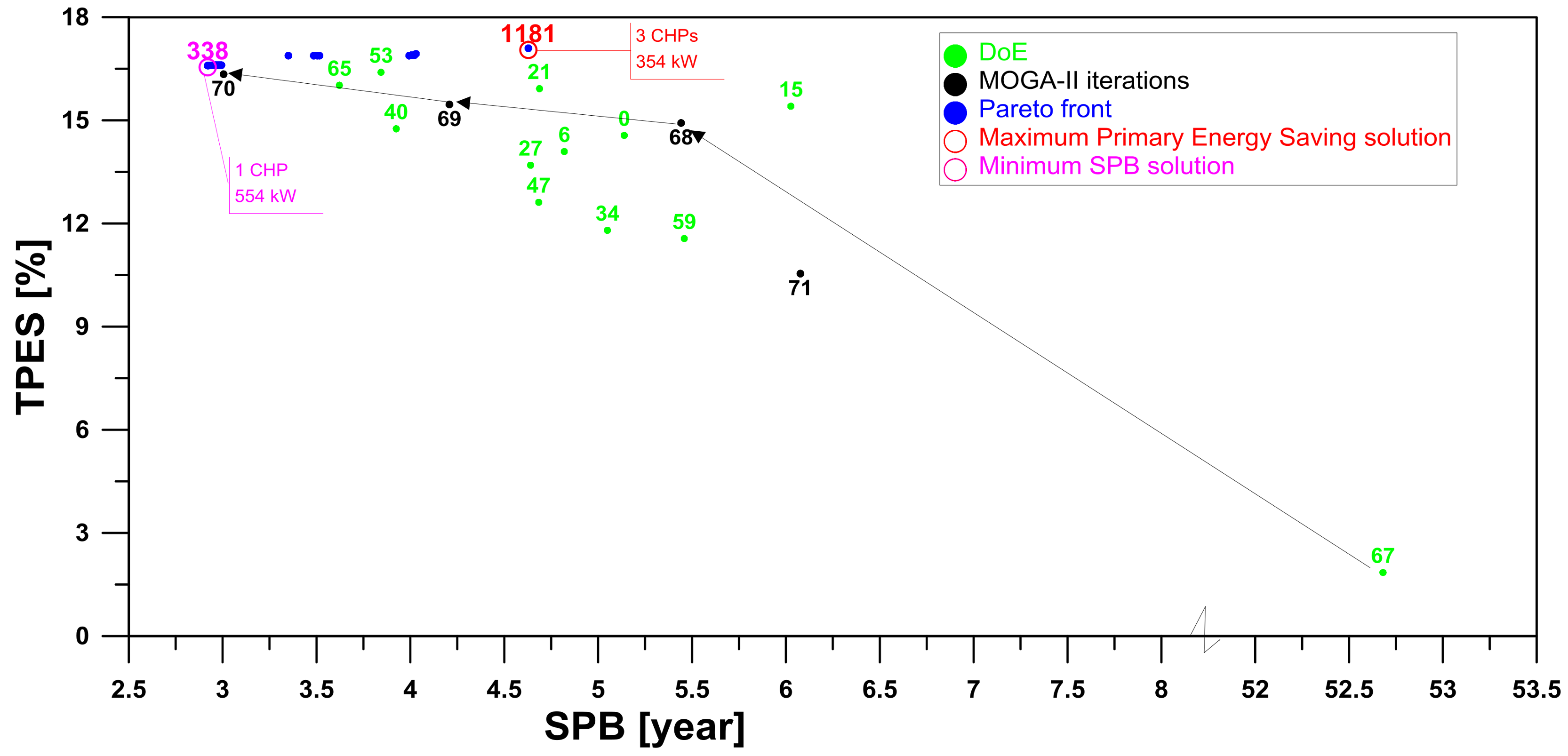
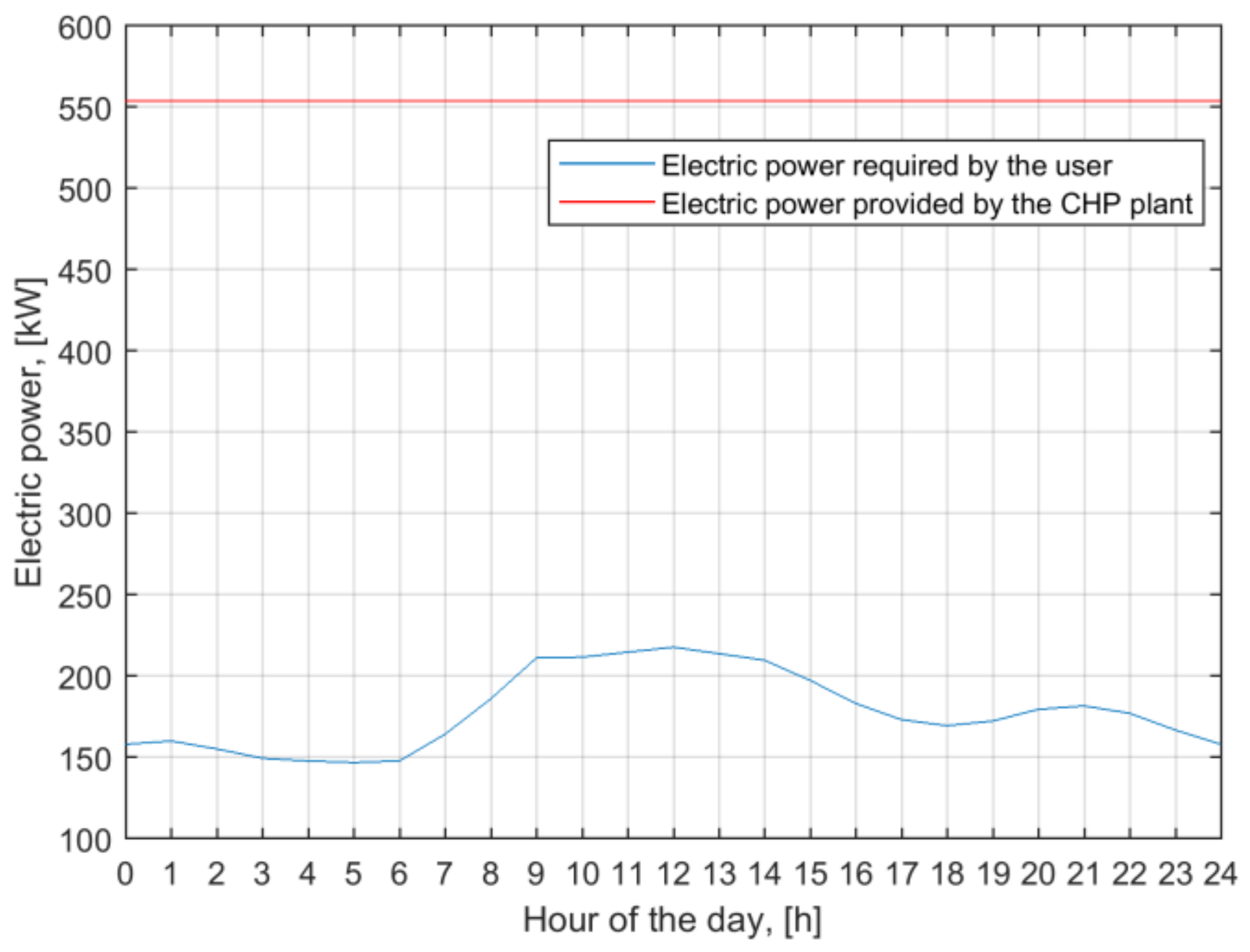
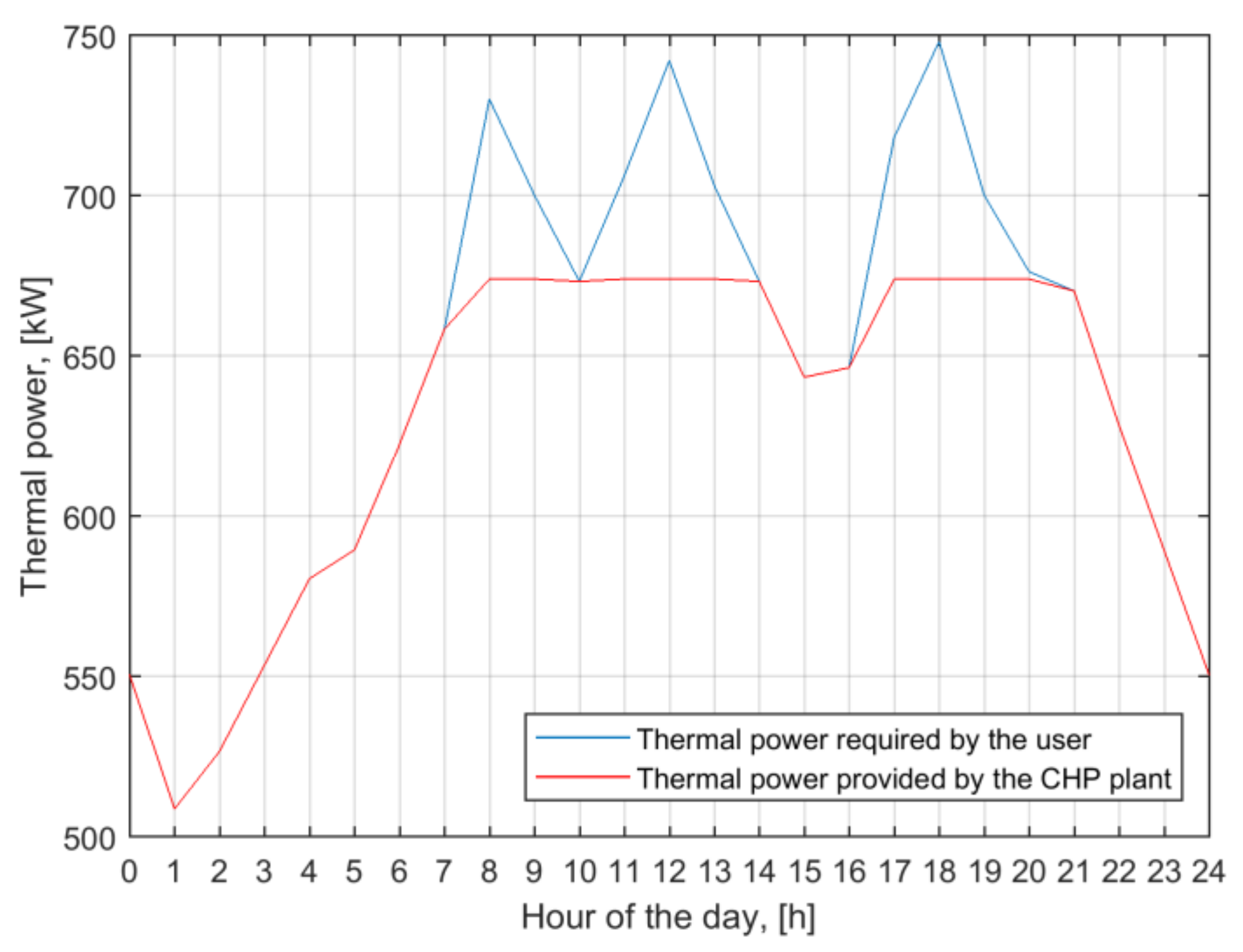
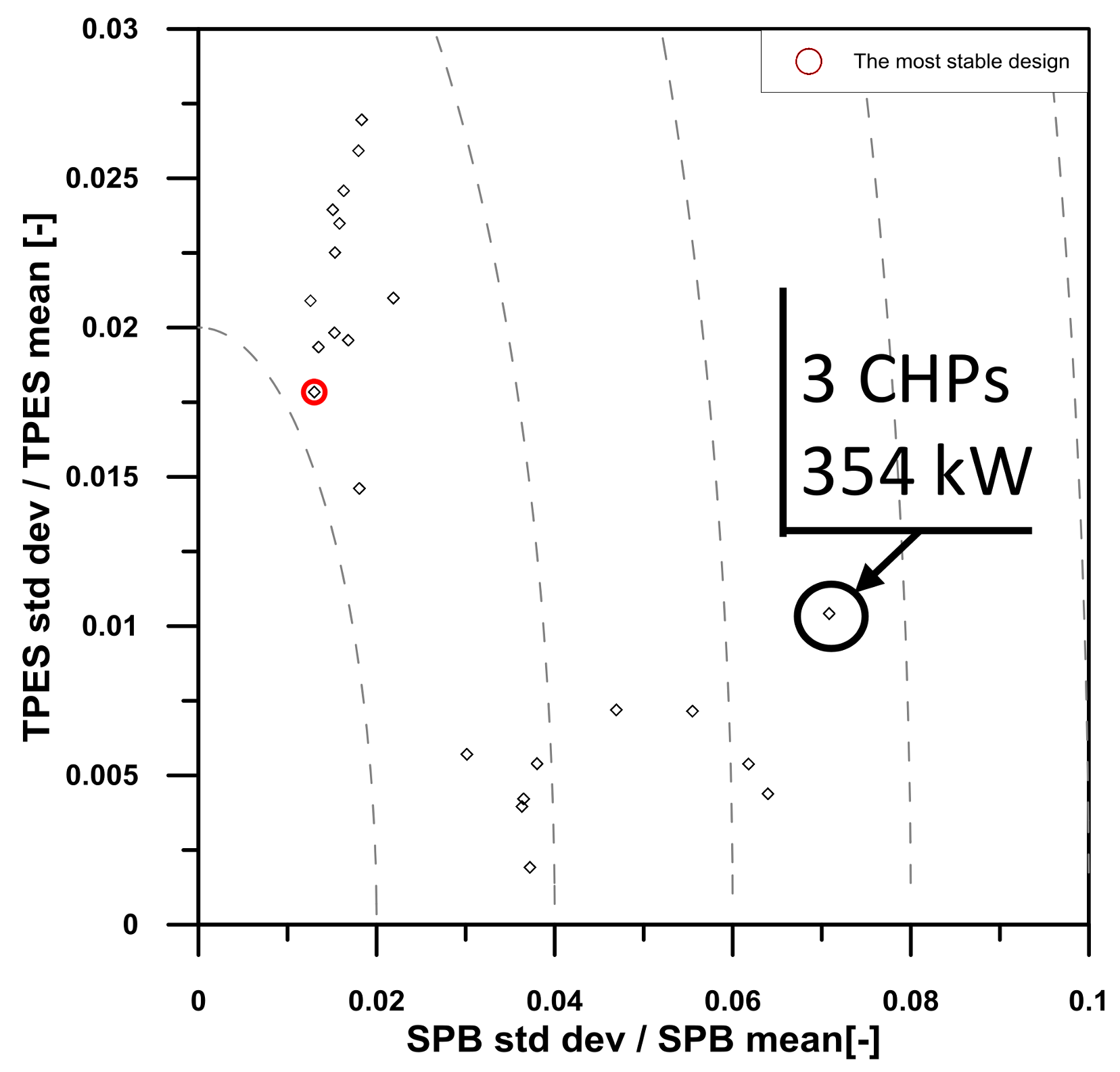

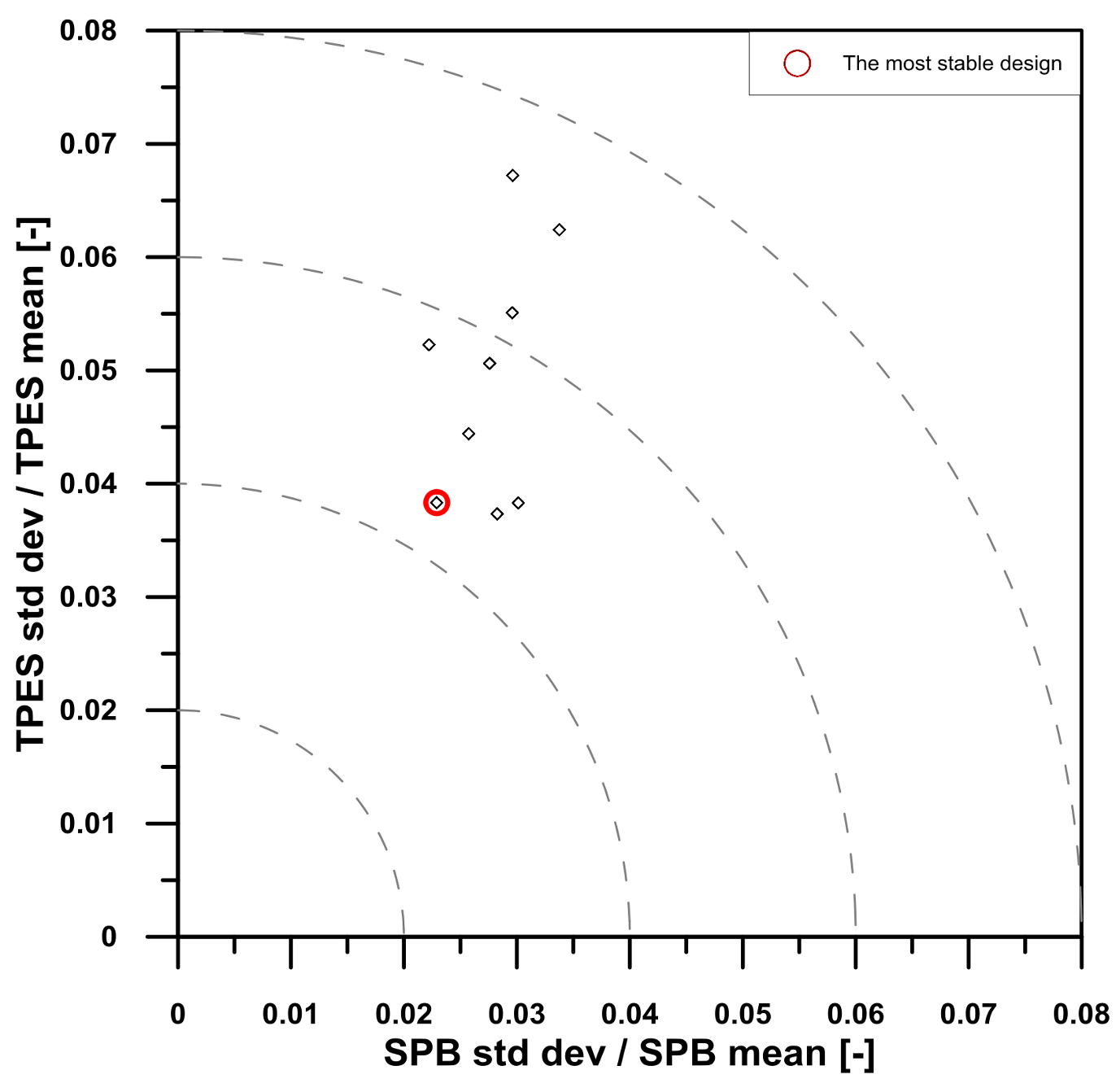
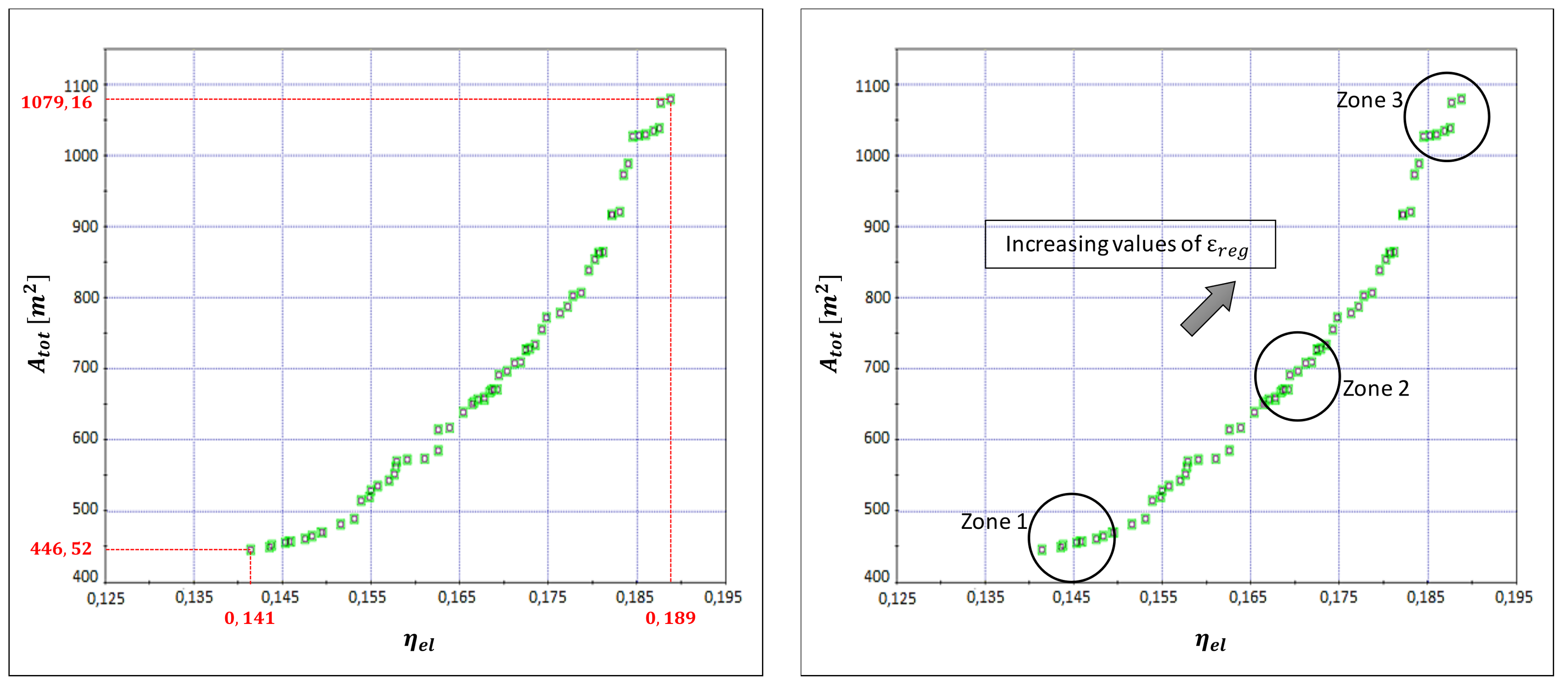
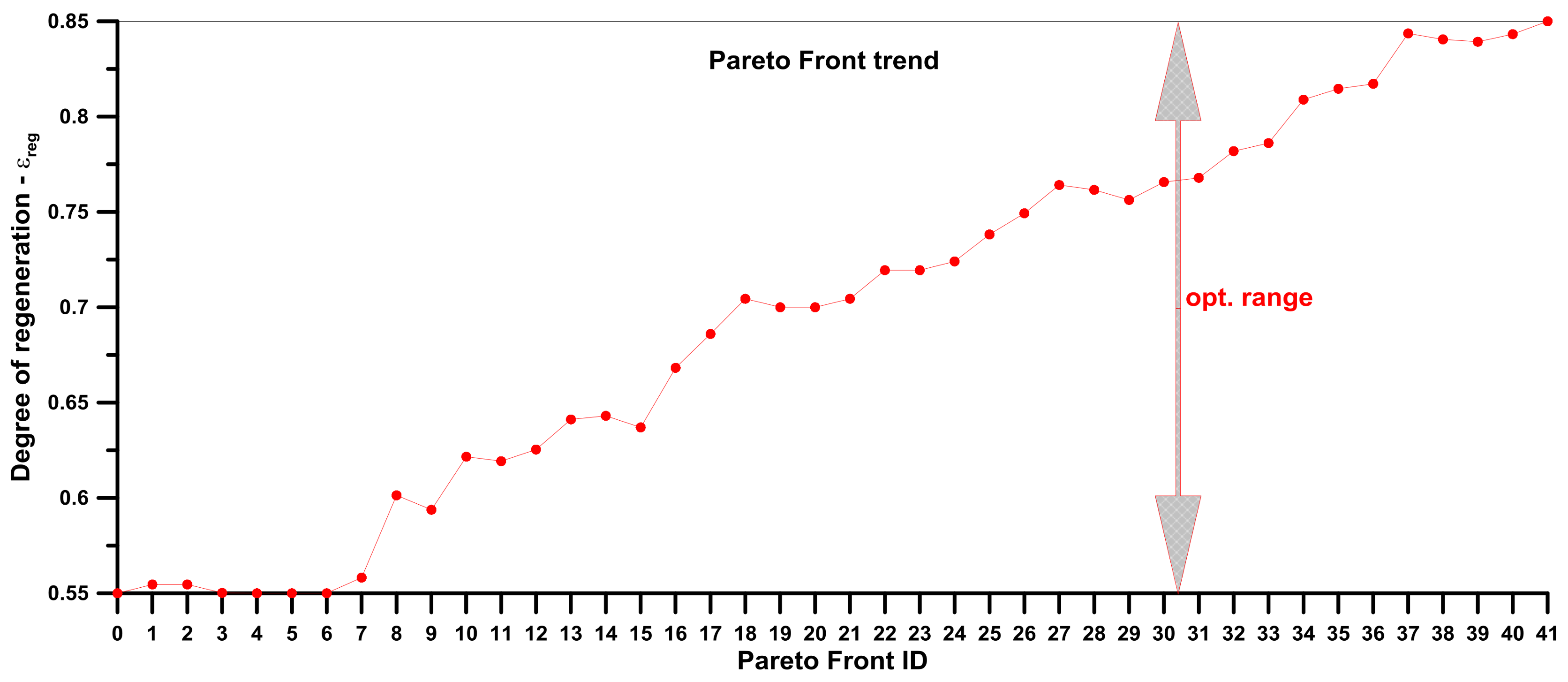
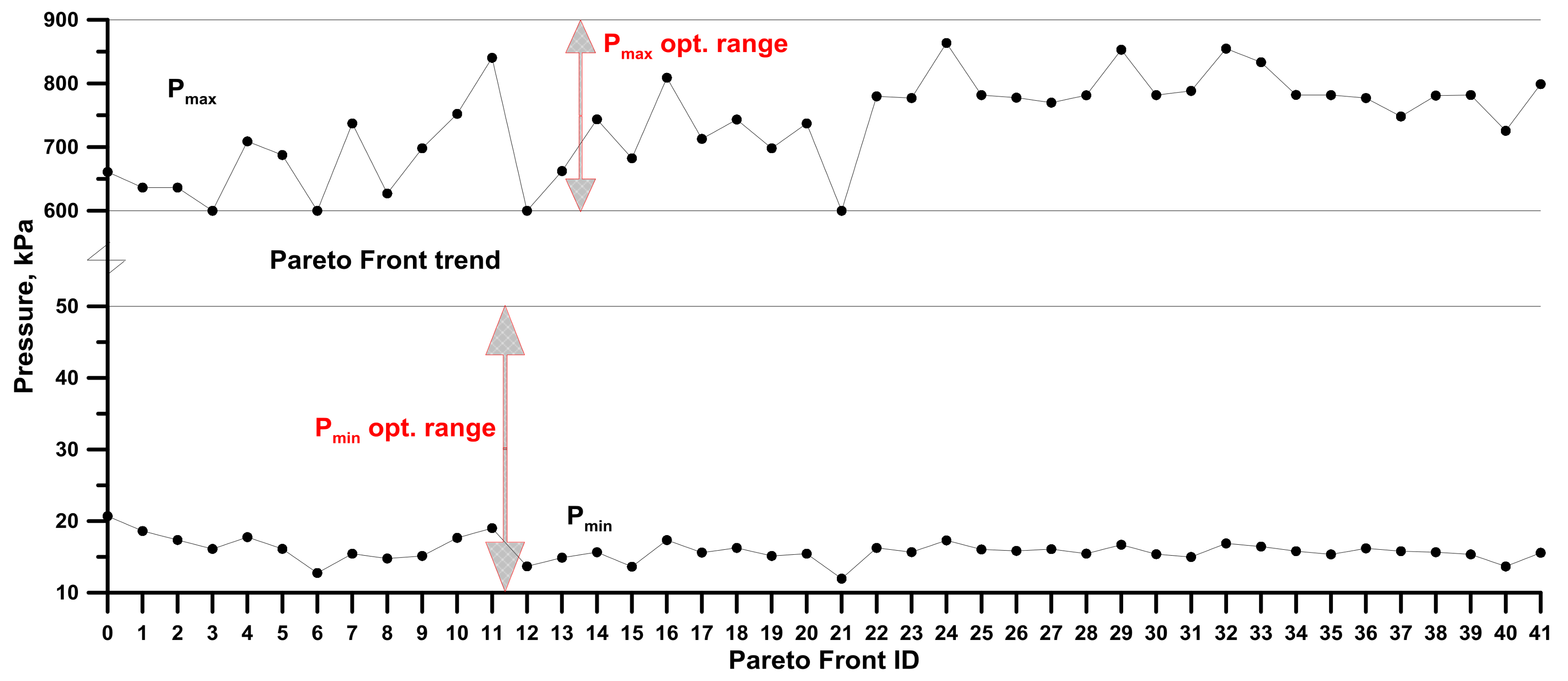
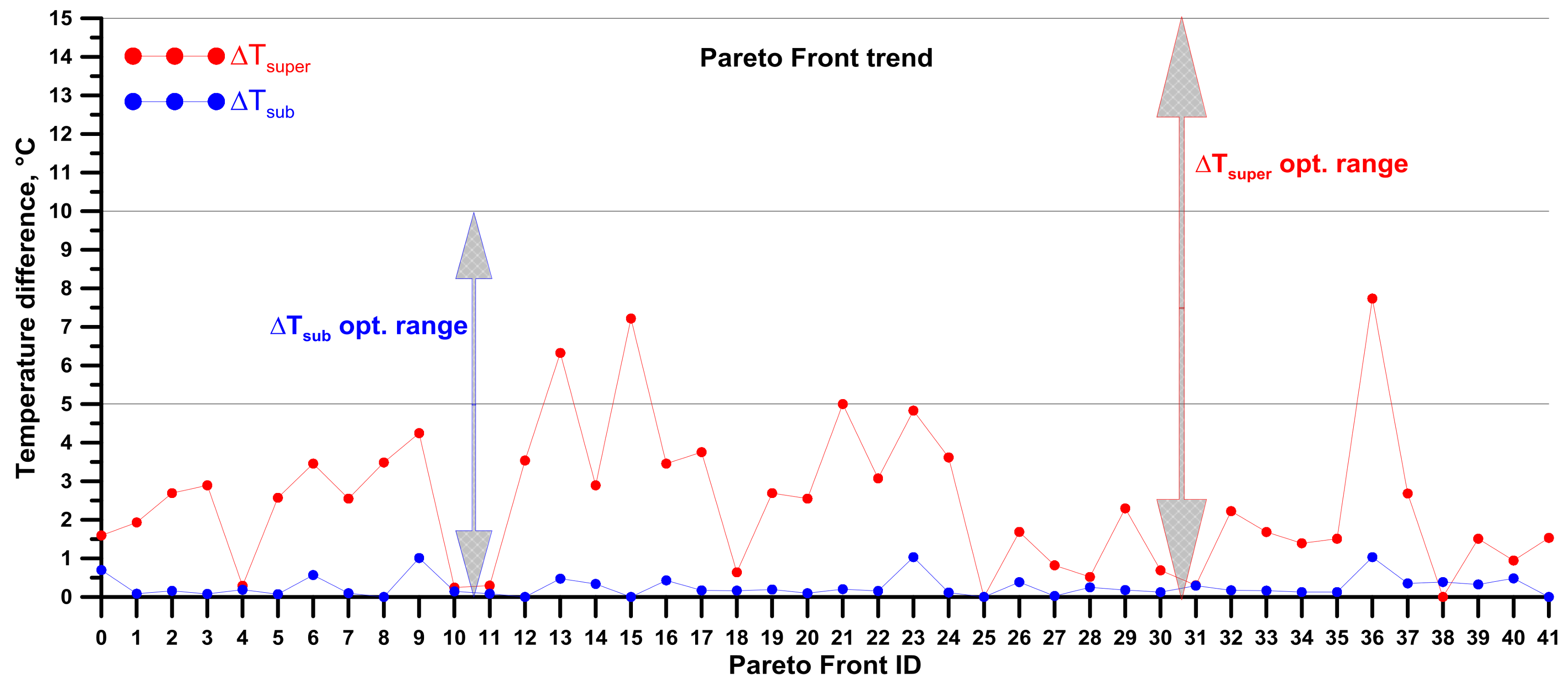
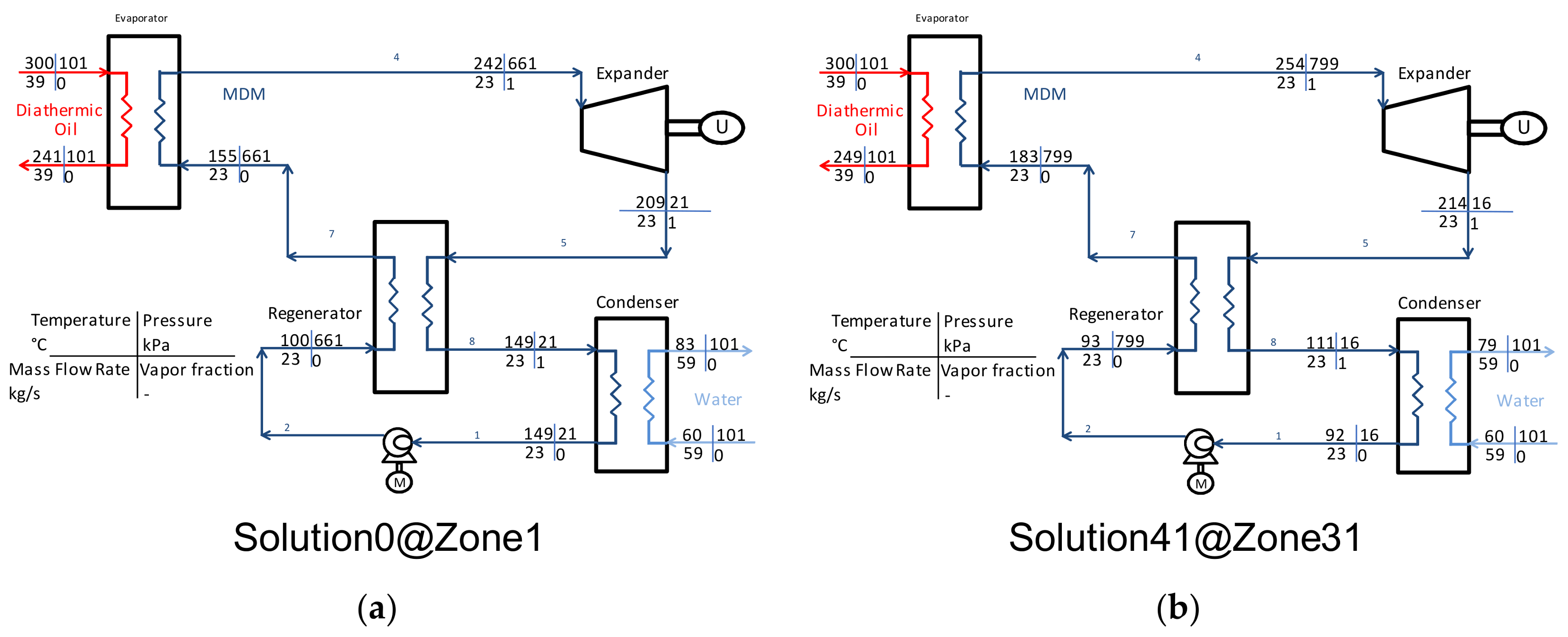
| DECISION VARIABLES | OBJECTIVE FUNCTIONS | ||
|---|---|---|---|
| VARIABLE | RANGE | OBJECTIVE | TARGET |
| Electric CHP power | 150–1000 kW | PES | maximize |
| CHP engine number | 1–9 | SPB | minimize |
| Decision Variable | Range of Definition |
|---|---|
| [°C] | |
| The Most Stable Solution | |||||||
|---|---|---|---|---|---|---|---|
| CHP engine number | Electrical power (mean) | TPES min | TPES mean | TPES max | SPB min | SPB mean | SPB max |
| [-] | [kW] | [%] | [%] | [%] | [years] | [years] | [years] |
| 1 | 482.19 | 14.32 | 14.87 | 15.23 | 2.91 | 2.98 | 3.05 |
| Input Decision Variable | Range | Unit | Distribution | Standard Dev. |
|---|---|---|---|---|
| Selling price in time period F1 | 0.10–0.14 | €/kWh | Normal | 0.003 |
| Selling price in time period F2 | 0.076–0.116 | €/kWh | Normal | 0.003 |
| Selling price in time period F3 | 0.045–0.085 | €/kWh | Normal | 0.003 |
| Reference efficiency | 43.5–48.5 | % | Normal | 1 |
| Selling price for the EEC | 90–110 | €/certificate | Normal | 3 |
| The Most Stable Solution | |||||||
|---|---|---|---|---|---|---|---|
| CHP number | Electrical power (mean) | TPES min | TPES mean | TPES max | SPB min | SPB mean | SPB Max |
| [-] | [kW] | [%] | [%] | [%] | [years] | [years] | [years] |
| 3 | 331 | 17.12 | 17.69 | 19.25 | 4.45 | 4.58 | 4.79 |
| Solution–Zone | Decision Variables | Objective Functions | |||||
|---|---|---|---|---|---|---|---|
| [kPa] | [kPa] | [°C] | [°C] | [m2] | |||
| Solution 0–Zone 1 | 20.70 | 661.05 | 0.55 | 1.60 | 0.70 | 446.52 | 0.141 |
| Solution 20–Zone 2 | 16.26 | 687.71 | 0.64 | 7.19 | 0.16 | 570.78 | 0.158 |
| Solution 41–Zone 3 | 16.04 | 771.18 | 0.74 | 0.00 | 0.00 | 727.00 | 0.172 |
© 2018 by the authors. Licensee MDPI, Basel, Switzerland. This article is an open access article distributed under the terms and conditions of the Creative Commons Attribution (CC BY) license (http://creativecommons.org/licenses/by/4.0/).
Share and Cite
Gimelli, A.; Muccillo, M. The Key Role of the Vector Optimization Algorithm and Robust Design Approach for the Design of Polygeneration Systems. Energies 2018, 11, 821. https://doi.org/10.3390/en11040821
Gimelli A, Muccillo M. The Key Role of the Vector Optimization Algorithm and Robust Design Approach for the Design of Polygeneration Systems. Energies. 2018; 11(4):821. https://doi.org/10.3390/en11040821
Chicago/Turabian StyleGimelli, Alfredo, and Massimiliano Muccillo. 2018. "The Key Role of the Vector Optimization Algorithm and Robust Design Approach for the Design of Polygeneration Systems" Energies 11, no. 4: 821. https://doi.org/10.3390/en11040821
APA StyleGimelli, A., & Muccillo, M. (2018). The Key Role of the Vector Optimization Algorithm and Robust Design Approach for the Design of Polygeneration Systems. Energies, 11(4), 821. https://doi.org/10.3390/en11040821





